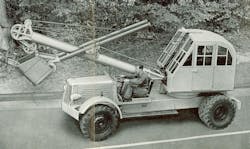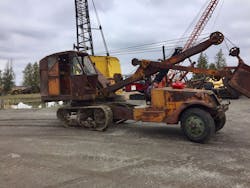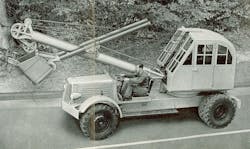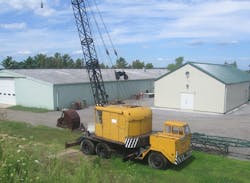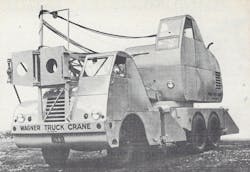Early Truck Cranes
Each example of early truck cranes illustrates a step in how these machines evolved in the early and mid-20th century.
The first truck cranes were designed to be mounted on conventional over-the-road-trucks. Most often these trucks had rubber tires (including solid tires in their day), but half-track conversion attachments were available to give the truck mobility over poor ground conditions. This idea reached its fulfillment after World War II when Bantam and Quickway bought thousands of surplus military trucks, including halftracks, and reconditioned them for use as carriers for their cranes. This is the National Construction Equipment Museum’s 1954 Bantam T-35, mounted on a 1941 White halftrack.
In the 1930s, Michigan Power Shovel Co. became the first crane manufacturer to provide carriers for its cranes. The crane is powered by a vertical shaft through the center pin from the truck’s engine. It also illustrates how truck cranes came to be equipped with shovel and backhoe fronts along with crane and dragline booms.
Thew Shovel Co. Universal Crane Co. division developed the first truck-mounted crane in 1919. In 1939, Thew introduced the first modern truck crane. Rated at 15 tons capacity, it rode a Thew-built carrier while having its own engine like the original truck cranes. Thew marketed a 75-mile road test for all its carriers—the distance the carrier was driven from a plant in Bucyrus, Ohio, to the Thew plant in Lorain for final assembly. The National Construction Equipment Museum owns this 1945 MC-414 model.
Circa 1950, Mixermobile Manufacturers offered this distinctive 10-ton capacity crane. Powered by Chrysler gas engines in the crane and carrier, its 50-foot pin-connected boom could be folded down by one man to keep the machine under permit size limits while eliminating the hazard posed during travel by a protruding boom. It also had two patented features: a conical mount for the upper works and easily deployable, hand-cranked outriggers. It was evidently not a success.
The Historical Construction Equipment Association (HCEA) is a 501(c)3 non-profit organization dedicated to preserving the history of the construction, dredging and surface mining equipment industries. With over 3,800 members in twenty-five countries, our activities include publication of a quarterly educational magazine, Equipment Echoes, from which this article is adapted; operation of National Construction Equipment Museum and archives in Bowling Green, Ohio; and hosting an annual working exhibition of restored construction equipment.
